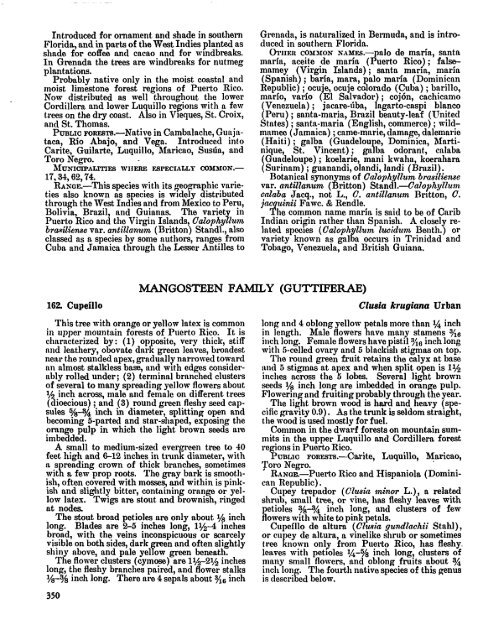Common Trees of Puerto Rico and the Virgin Islands
Common Trees of Puerto Rico and the Virgin Islands
Common Trees of Puerto Rico and the Virgin Islands
Create successful ePaper yourself
Turn your PDF publications into a flip-book with our unique Google optimized e-Paper software.
Introduced for ornament <strong>and</strong> shade in sou<strong>the</strong>rn<br />
Florida, <strong>and</strong> in parts <strong>of</strong> <strong>the</strong> We& Indies planted as<br />
shade for c<strong>of</strong>fee <strong>and</strong> cacao <strong>and</strong> for n-indbreaks.<br />
In Grenada <strong>the</strong> trees are windbreaks for nutmeg<br />
plantations.<br />
Probably native only in <strong>the</strong> moist coastal <strong>and</strong><br />
moist limestone forest regions <strong>of</strong> <strong>Puerto</strong> <strong>Rico</strong>.<br />
Now distributed as well throughout <strong>the</strong> lower<br />
Cordillera <strong>and</strong> lower Luquillo regions with a few<br />
txees on <strong>the</strong> dry coast. Also in Vieques, St. Croix,<br />
<strong>and</strong> St. Thomas.<br />
PWLIG FOREGTS.-N~~~V~ in Cambalache, Guaja-<br />
taca, Rio Abajo, <strong>and</strong> Vega. Introduced into<br />
Carite, Guilarte, Luquillo, Afaricno, Susiia, <strong>and</strong><br />
Toro Nep.<br />
X~USIOIPALITIES WIIEN: FSPECWLLY WMXON.-<br />
17,34,62,74.<br />
RASGE.-This species with its geo,~phic varie-<br />
ties also known as species is w~dely distributed<br />
through <strong>the</strong> West Indies <strong>and</strong> from Mexico to Peru,<br />
Bolivia, Brazil, <strong>and</strong> Guianas. The variet in<br />
<strong>Puerto</strong> <strong>Rico</strong> <strong>and</strong> <strong>the</strong> <strong>Virgin</strong> Isl<strong>and</strong>s, Calophy turn<br />
bre~iliense var. antildanum (Britton) St<strong>and</strong>l., also<br />
classed as a species by some authors, ranges from<br />
Cuba <strong>and</strong> Jamaica through <strong>the</strong> Lesser Antilles to<br />
f<br />
Grenada, is naturalized in Bermuda, <strong>and</strong> is introduced<br />
in sou<strong>the</strong>rn Florida.<br />
OTIIEI~ COXJLON XAMES.- 1110 de maria, santa<br />
maria, aceit8 de maria ( 3 uerto <strong>Rico</strong>); falsemnmey<br />
(<strong>Virgin</strong> Isl<strong>and</strong>s) ; santa maria, maria<br />
(Spanish) ; baria, mara, a10 maria (Dominican<br />
Republic) ; ocuje, ocuje ca 7 omdo (Cuba) ; barillo,<br />
mario, varh (El Salvador) ; coj6n, c~cl~icamo<br />
Venezuela) ; jacare-dba, agarto-casp~ blanco<br />
(Perul ; santa-maria, Brazil beauty-leaf (Vniteil<br />
States ; santa-maria (English, commerce) ; wildmnmee<br />
(Jamaica) ; came-marie, damage, dalemarie<br />
(Haiti) ; galba (Guadelou e, Dominica, Martinique,<br />
St. Vincent); gn T ba odorant, calaba<br />
Guadeloupe) ; koelarie, mani kxvaha, koernhara<br />
Surinam) ; guan<strong>and</strong>i, ol<strong>and</strong>i, l<strong>and</strong>i (Bmzil).<br />
Botanical synonyms <strong>of</strong> Cdop hy llum brasiliense<br />
var. anti22anum (Britton) St<strong>and</strong>1.-CaZoyhyZZum<br />
cdaba Jacq., not L., 0. antillanurn Rritton, 0.<br />
jacpuinii Fawc. & Rendle.<br />
'l he common name maria is said to be <strong>of</strong> Carib<br />
Indian origin ra<strong>the</strong>r than Spanish. A closely related<br />
species (Cdoph Zlum Zucidzcrn Benth.) or<br />
variety known as gal g a occurs in Trinidad <strong>and</strong><br />
Tobago, Venezuela, <strong>and</strong> British Guiana.<br />
MANGOSTEEN FAMILY (GUTTIFERAE)<br />
162 Cupeillo Clusia krugiana Urban<br />
This tree with orange or yellow latex is common<br />
in upper mountain forests <strong>of</strong> <strong>Puerto</strong> <strong>Rico</strong>. It is<br />
characterized by: (1) op osite, very thick, stiff<br />
<strong>and</strong> lea<strong>the</strong>ry, obovate dnr E green leaves, broadest<br />
near <strong>the</strong> rounded apex, jpxdunlly narrowed toward<br />
an almost stalkless bnse, <strong>and</strong> with edges considerably<br />
rolled under; (2) terminal brnnched clusters<br />
<strong>of</strong> several to many sprending yellow flowers about<br />
1/2 inch across, male <strong>and</strong> female on different trees<br />
(dioecious) ; <strong>and</strong> (3) round green fleshy seed capsules<br />
5/8-3/p inch in diameter, splitting open <strong>and</strong><br />
becoming 5-parted <strong>and</strong> star-shaped, exposing <strong>the</strong><br />
orange pulp in which <strong>the</strong> light brown seeds are<br />
imbedded.<br />
A small to medium-sized ever reen tree to 40<br />
feet high <strong>and</strong> 6-12 inches in trun diameter, with<br />
a s reading crown <strong>of</strong> thick brnnches, sometimes<br />
wit 1 a few prop roots. The gray bark is smoothish,<br />
<strong>of</strong>ten covered with mossesZ <strong>and</strong> within is pinkish<br />
<strong>and</strong> slightly bitter, containing orange or yellow<br />
latex. Twigs are stout <strong>and</strong> brownish, ringed<br />
at nodes<br />
The stout broad petioles are only about % inch<br />
long. Blades are 2-5 inches long, 14/24 inches<br />
broad, with <strong>the</strong> veins inconspicuous or scarcely<br />
visible on both sides, dark en <strong>and</strong> <strong>of</strong>ten slightly<br />
Y-<br />
shiny above, <strong>and</strong> pale ye1 ow peen beneath.<br />
The flower clusters (cymose) are 1%-2% inches<br />
long, <strong>the</strong> fleshy branches paired, <strong>and</strong> flower stalks<br />
%-94 inch long. There are 4 sepals about s/16 inch<br />
R.<br />
long <strong>and</strong> 4 oblong yellow etals more than inch<br />
in length. Male flowers \ ave many stamens 3/le<br />
inch long. Female flowers have pistil inch long<br />
wit11 5-celled ovary <strong>and</strong> 5 blackish stigmas on top.<br />
The round green hit retains <strong>the</strong> calyx at base<br />
<strong>and</strong> 5 stigmas at apex <strong>and</strong> when split o en is 1%<br />
inches wross <strong>the</strong> 5 lobes. Several lig \ t brown<br />
seeds l/g inch long are imbedded in orange pulp.<br />
Flowerin <strong>and</strong> fruiting probably through <strong>the</strong> year.<br />
The lig Ch t brown wood is hard <strong>and</strong> heavy (s e-<br />
cific gravity 0.9). As <strong>the</strong> trunk is ssldom straig t,<br />
tlie wood is used mostly for fuel.<br />
1<br />
<strong>Common</strong> in <strong>the</strong> dwarf forests on mountain summits<br />
in <strong>the</strong> upper Luquillo <strong>and</strong> Cordillera forest<br />
re ions in <strong>Puerto</strong> <strong>Rico</strong>.<br />
%UULIG FORESTS.-Csrite, Luquillo, Maricao,<br />
Tor0 Negro.<br />
RANQE.-PuC!~~O <strong>Rico</strong> <strong>and</strong> Hispaniola (Dominican<br />
Republic).<br />
Cupey trepador (Clusin minor L.), a related<br />
shrub, small tree, or vine, hns fleshy leaves with<br />
petioles 3/g--3/4 inch long, <strong>and</strong> clusters <strong>of</strong> few<br />
flowers with white to pink petals.<br />
Cupeillo de altum (Ctwia gundlachii Stahl),<br />
or cu ey de altura, a vinelike shrnb or sometimes<br />
tree t: non-n only from <strong>Puerto</strong> Rim, has fleshy.<br />
let~ves with petioles %-% inch long, clusters <strong>of</strong><br />
many small flowers, <strong>and</strong> oblong fruits about %<br />
. The fourth native species <strong>of</strong> this genus<br />
il'ch is descri lo"& ed below.

















